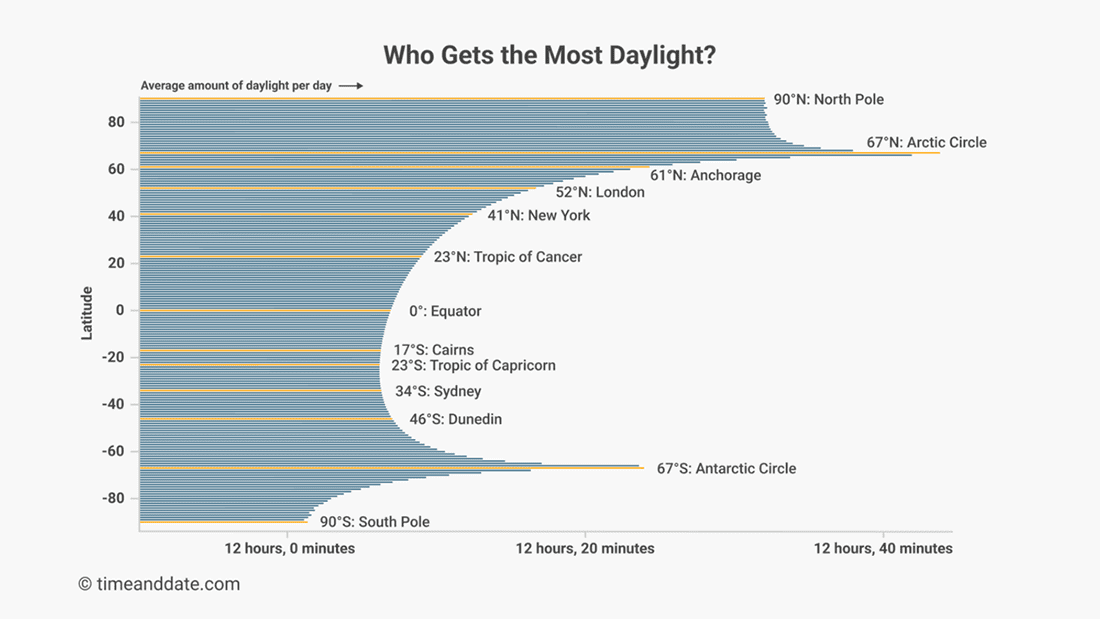Whether you’re a photosynthesizing triffid seeking out the rays or just a vampire, you may have wondered at some point: Where on Earth gets the most and least sunlight?
Well, the team at timeanddate.com have an answer for you, and it comes with a few surprises. For instance, it turns out that Bodø in Norway gets on average 36.5 more minutes of daylight per day than Sydney, Australia. How? It comes down to refraction, hemisphere, and latitude.
The amount of time you see daylight (on average) per day anywhere on the planet is over 12 hours. This might seem odd, given that there are 24 hours in a day and it’s reasonable to think (from the diagrams you saw in school) that when your half is in the day, the other must be experiencing night. However, we actually get a little more sunlight thanks to the Earth’s atmosphere, which refracts light slightly, meaning that you get a little bit of light before the Sun has technically risen over the horizon in the morning, and after the Sun has disappeared behind it at night.
The amount of this refracted light you get depends on your latitude.
“Earth spins on its axis with the tropics – the region of the globe that straddles the equator – pointed toward the Sun. Therefore, around the equator, the Sun tends to rise straight upward from the horizon,” Time and Date explain on their website.
“As we travel north or south from the tropics, the Sun rises at more of a slope. In the northern hemisphere, the Sun moves along the horizon from left to right at sunrise and sunset; in the southern hemisphere, it moves from right to left.”
“The effect of this slope is that sunrise and sunset take longer: the top edge of the Sun appears even earlier at sunrise; the bottom edge disappears even later at sunset.”
Your hemisphere affects how much sunlight you get too, in that you get a longer summer in the Northern Hemisphere than the Southern Hemisphere, thanks to the fact that our planet’s orbit is elliptical rather than a perfect circle.
On average, the Northern Hemisphere gets 93.6 days of summer vs the Southern Hemisphere’s 89. This shift is felt especially at the poles. In the Arctic Circle, where the summers are long, the average amount of daylight per day is around 12 hours 40 minutes, while at the South Pole – which gets the least daylight on the planet – the average daylight time is just 12 hours.
Sydney, hit by being in the Southern Hemisphere and its latitude, gets over 9 days less sunlight in total per year than Bodø in Norway. London, though it likes to complain of a lack of it, gets around 12 hours 20 minutes a day, around 10 minutes more than Sydney. New York sits in between the two, getting about 12 hours and 15 minutes of daylight per day.

If you want to go to the location where you get the most sunlight, however, you need some altitude. In 2018, writer Grant Hutchison looked for high-altitude places near the Arctic Circle, where sunlight can be seen later thanks to the high vantage point. He found that the summit of Mount Forel, Greenland, gets 5,052 hours of daylight a year, more than anywhere else on the planet.
All “explainer” articles are confirmed by fact checkers to be correct at time of publishing. Text, images, and links may be edited, removed, or added to at a later date to keep information current.
Source Link: Where On The Planet Gets The Most And Least Sunlight?